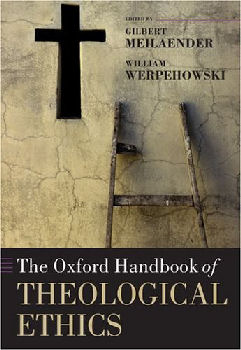
|
Posted March 9, 2006
Book: The Oxford Handbook of Theological Ethics Edited by: Gilbert Meilaender and William Werpehowski Oxford University Press, New York, 2005, pp. 546 An Excerpt from the Jacket:
An Excerpt from the Book: Christians and Family The death of unconstrained patriarchy, the end of the status of wives and children as chattel, and the prohibition of child labor hardly signal that family life in the twenty-first century America is now morally safe. Where once we faced the temptations associated with hardship and poverty, we are now surrounded by the more insidious temptations afforded by comfort and affluence. American culture offers a full range of corruptions, shaped by its distinctive features of consumer capitalism and technological self-confidence. Marriage is now explicitly a life-style choice, an economic strategy, and courtship is more and more overtly conducted in a marketplace complete with advertising, both veiled and direct. In similar vein, we are offered a thousand subtle abuses of parental power by which we can make our children means to our ends, the vindication of our self-worth, or th vicarious fulfillment of our thwarted desires. Their methods range from the expensive grooming provided children of the rich in private academies, to the various uses of genetic tests and techniques to ensure that the children born to those who can afford these interventions will be desirable and rewarding. Luther’s children of God entrusted to our care’ are readily converted into one more category of the possessions by which we mark our achievement of the American dream, and demonstrate our success in the economic competition that so pervades our consumer society by purchasing for them every advantage. Now, as in every age, ‘sin crouches at the door’ of the household, and we need the full range of our moral and spiritual resources to recognize and resist it. It is in the heart of the family, as we confront spouse and sibling, son and daughter, so nearly images of ourselves, that the true otherness of the other — their final belongings to God and not to us — is hardest to see, and hardest to honor. Only when our own hearts are converted, only when our natural loves are disciplined by charity and reordered to the priorities of disciples, can we learn to see and to turn from all the subtle distortions of family life. These take their particular shapes in the matrix of a particular society, but this does not make them either new or less potent. It only makes them harder for us to recognize. Table of Contents: Part I Dogmatics and Ethics 1. Creation and ethics 2. Redemption and ethics 3. Eschatology and ethics 4. Ecclesiology and ethics 5. Divine grace and ethics Part II Sources of Moral Knowledge 6. Scripture 7. Divine commands 8. Tradition in the Church 9. Reason and natural law 10. Experience Part III The Structure of the Christian Life 11. Vocation 12. Virtue 13. Rules 14. Responsibility 15. Death Part IV The Spirit of the Christian Life 16. Faith 17. Hope 18. Love: a kinship of affliction and redemption Part V Spheres of the Christian Life 19. Christians and government 20. Christians and family 21. Christians and economics 22. Christians and culture 23. Christians and the Church Part VI The Structure of Theological Ethics: Books that Give Shape to the Field 24. Ernst Troeltsch’s The Social Teaching of the Christian Churches 25. Anders Nygren’s Agage and Eros 26. Kenneth Kirk’s The Vision of God 27. H. Richard Niebuhr’s Christ and Culture 28. Reinhold Niebuhr’s The Nature and Destiny of Man 29. John Mahoney’s The Making of Moral Theology 30. Catholic Social Teaching |
|
